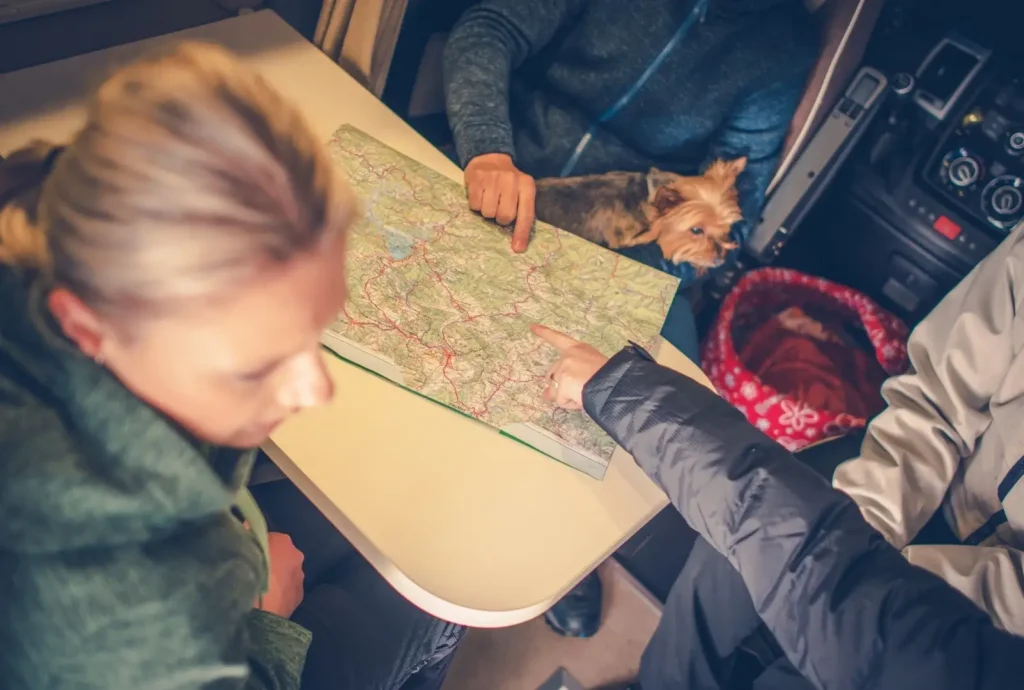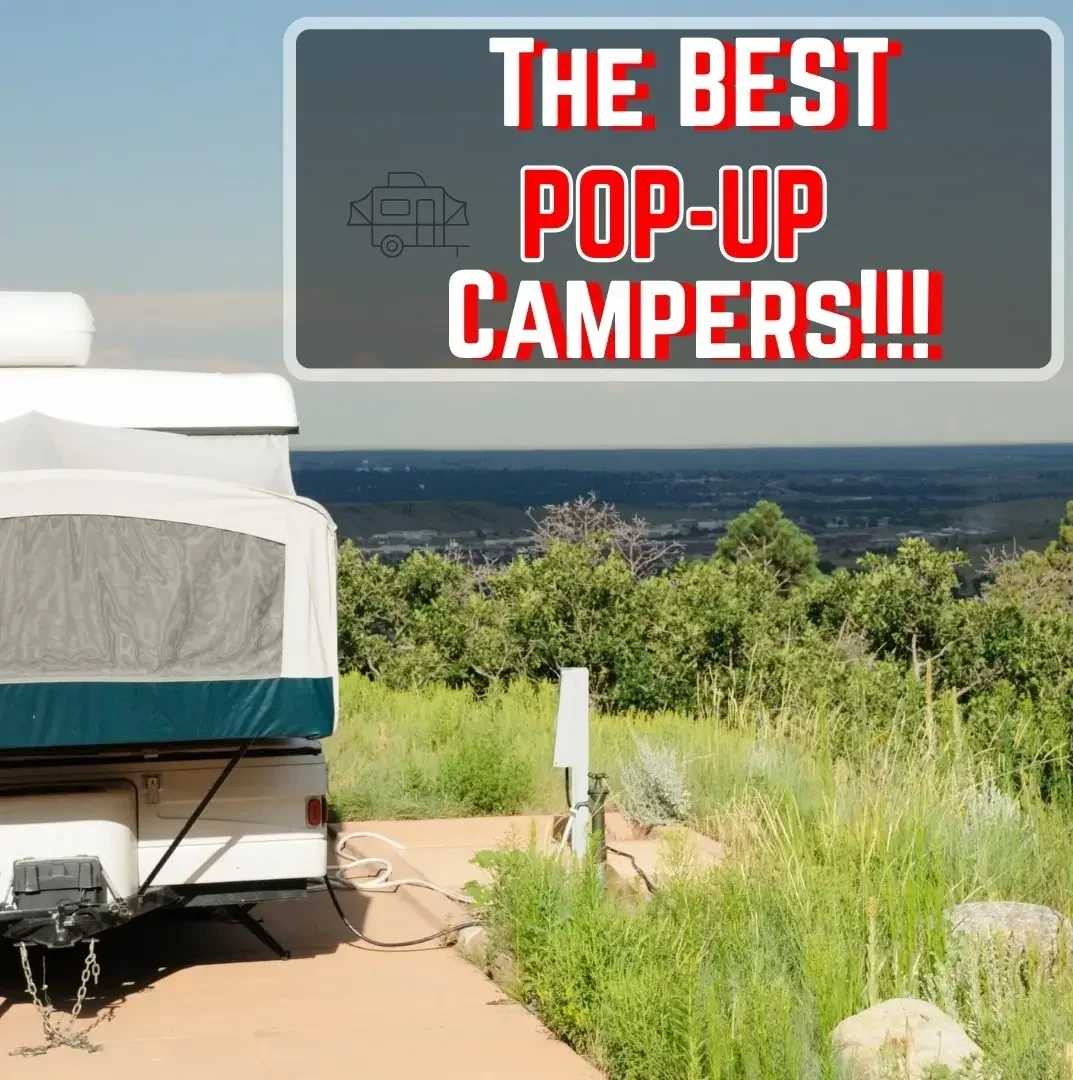Motor-homies, I want to introduce you to the world of pop-up camper trailers.
In our high-flying, all-consumer society, everybody loves a six-figure RV. But what if I told you there was a way to be closer to nature? Simpler. Cheaper. Birdsong in your ear and the breeze rustling through your hair on those lazy morning lie-ins.
Welcome to the world of the BEST pop-up campers.
What if we took a lightweight trailer and put a premium-feeling tent on it? Why, you would have combined the best of both worlds…
A versatile and easy-to-maneuver RV with the authenticity of a tent and just enough luxury for the crappy, rainy days inside!
I LOVE camping. And I LOVE doing it without the glam of picture-perfect, IG-friendly McMansions-on-wheels. But most of all-
I love pop-up campers.
Today, I’m breaking down the scene. We got campers for families… Boondockers… All-rounders… We’re going to find the best pop-up trailer for your camping style.
Pop in for a chat, motor-homie. It’s time to see what makes these pop-ups pop off!
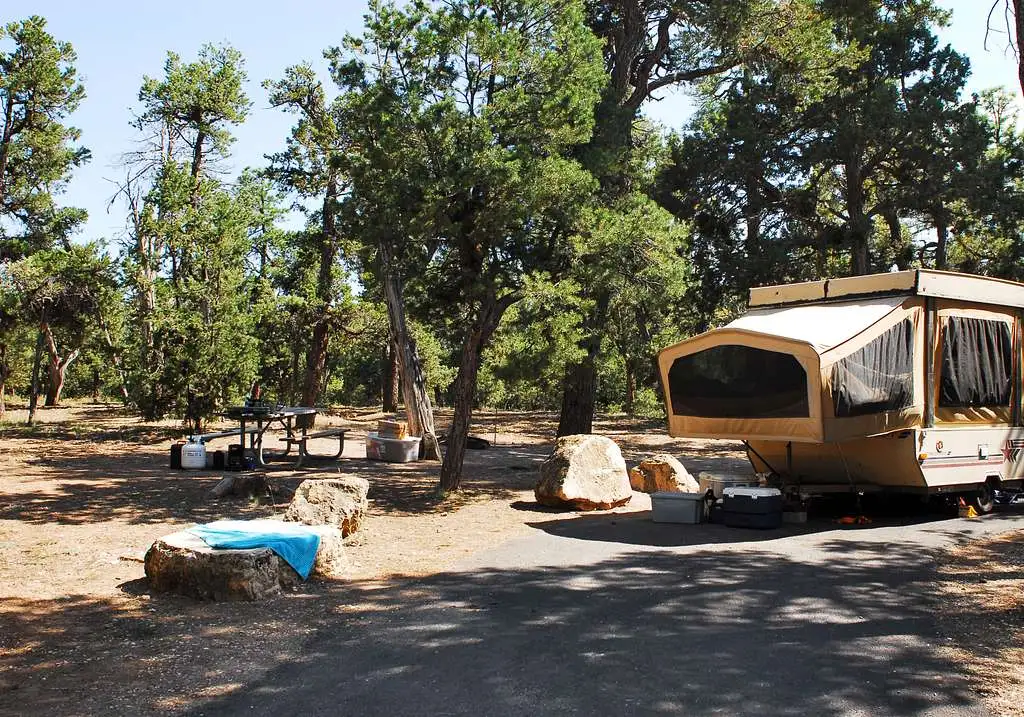
What is a Pop-Up Camper?
A pop-up camper is a recreational vehicle (RV) that goes by many names:
- Tent trailer
- Tent camper
- Pop-up trailer
- Folding camper
- Folding trailer
You get the gist.
Essentially, a pop-up is like the Swiss Army knife of towable RVs! They’re compact and lightweight on the road but spacious and comfortable at camp, all the while offering a style of travel you won’t find in other classes of towable or motorized RVs.
These clever rigs collapse down for easy towing and storage. Then, when it’s setup time at camp, they pop up (see what they did there?). They de-collapse and fold out into a livable space with soft sides, a hard floor, and (usually) a roof that lifts.
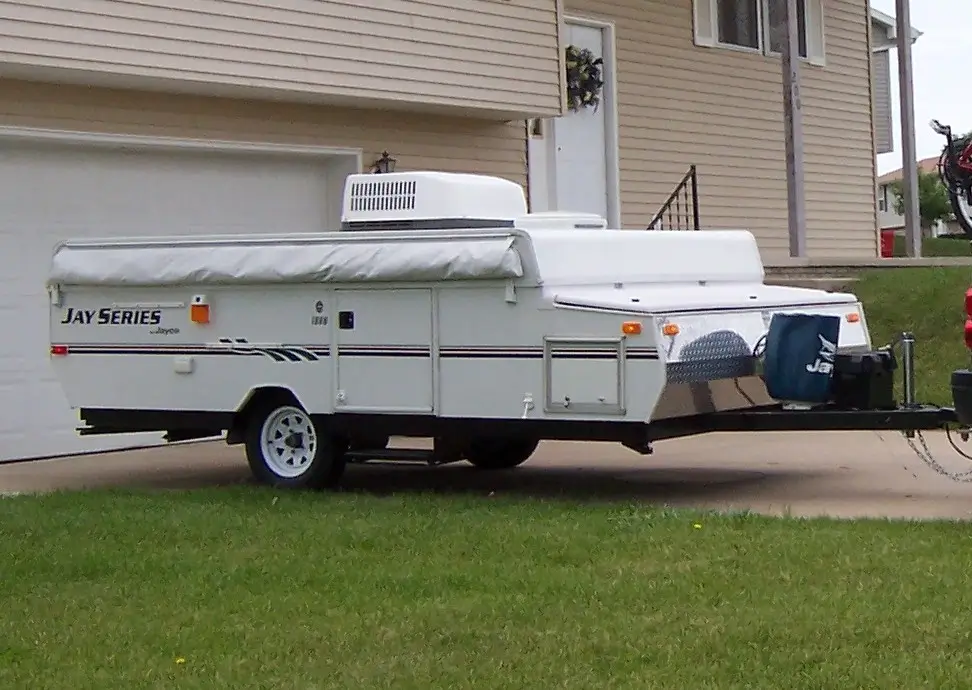
Most models use a crank system or power lift to raise the roof and extend two bed platforms off either end. This creates more space and adds sleeping areas without increasing the trailer’s overall towing length. Inside, you’ll typically find convertible dinettes, basic kitchens, and storage cubbies. Some even come with bathrooms and AC, plus they almost always have an awning for outdoor living too.
- The pros? Tent trailers are easy to tow, fit in garages, and are way cheaper than full-size travel trailers.
- But the cons? They’re less insulated, aren’t as stacked with amenities, and the soft walls aren’t great in nasty weather.
There are other compact towable RVing options, with some of the top teardrop trailer campers giving pop-ups a run for their money. But for a budget-friendly, lightweight RVing experience that feels like camping with just enough of the RV life glam still in tact, you can’t beat exploring with a pop-up.
Pop-Up Tent Campers Vs Travel Trailers: Which is Better?
But how ’bout a quick comparison? A travel trailer is the alternative to tent campers that many tow-folk prefer. Travel trailers are hard-sided, towable RVs that come in various sizes, from compact to colossal.
Unlike pop-up campers, travel trailers don’t fold out or require manual cranking for setup. (They do, however, require leveling, stabilizing, hook-ups, etc.) But structurally, what you see with a travel trailer is what you get:
- Solid walls…
- A fixed roof…
- More house, less tent…
- And a more traditional RV experience.
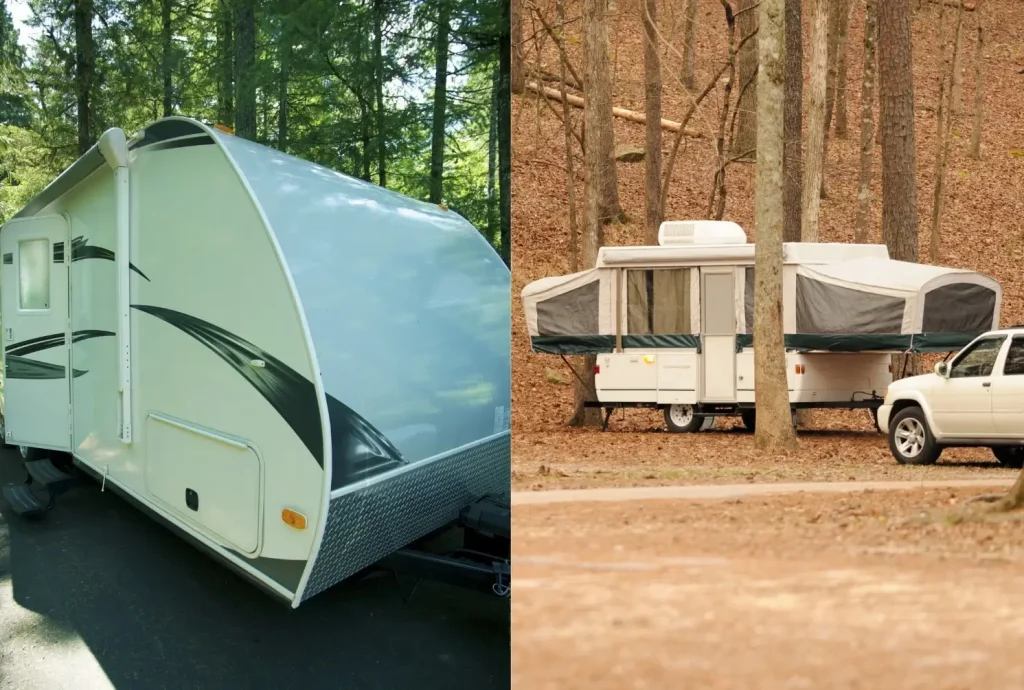
Deciding between the two depends on how you roll.
If you’re after a low-cost, easy-to-store, and light-to-tow adventure rig, pop-up campers are the clear winner. They’re perfect for long-terming singles or couples, weekend warriors or holidaying small families, and just folks who drive smaller SUVs with lower towing capacities.
If you want more comfort, insulation, and, dare I say it, luxury, I’d suggest checking out some of the leading travel trailer brands instead. They generally offer sounder infrastructure, better climate control, and way more features out of the box. (E.g., full bathrooms, bigger kitchens, and more built-in systems like electrical, propane, and plumbing.)
In short:
- Pop-up campers = simpler, cheaper, lighter.
- Travel trailers = comfier, roomier, more plug-and-play.
It’s your rig. It’s your rules. Just make sure you’re playing the right game. 🙂
Typical Features of Pop-Ups: What You Need to Consider Before Buying
Tent trailers indeed pack a surprising amount of functionality into a compact, collapsible design. But that doesn’t mean all are created equal!
Before we dive into specs, brands, and the best models of pop-up campers, here is what you need to consider for real-world use:
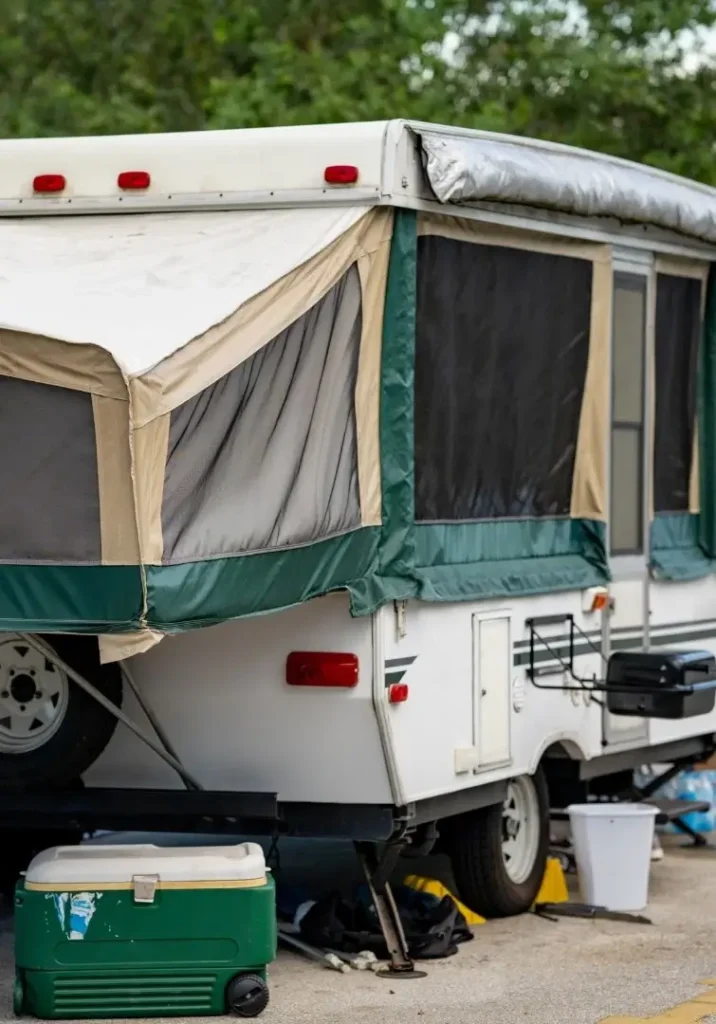
- Sleeping Space and Bed Count: Most pop-ups offer two slide-out beds, plus a convertible dinette or couch. That generally means sleeping room for four to six people, though some larger models push that to seven or more. Pay attention to the dimensions of the sleeping areas and mattresses too. Ensure it’s a good fit for you and any comfy replacement RV mattresses you want to install.
- Living Area: Pop-ups leverage clever design features to improve living space. It’s extremely common to see convertible furniture, collapsible tables, and multi-use areas. The best layouts will make use of every inch, so prioritize smart interior flow (and enough headroom!) so the fam can do its thing without stepping on each other’s toes.
- Full Kitchens: Some folding campers, despite their folding, have surprisingly robust kitchens. If you want things like stoves, sinks, mini-fridges, and even microwaves, it is possible! Just look for higher-end models. (And as a bonus, some models even offer removable kitchen modules for use outdoors when the weather plays nice.)
- Storage Space: You won’t necessarily find the cavernous storage of full-sized trailers and Class A motorhomes in pop-ups. But you will find clever storage. Keep an eye out for under-seat compartments, external access doors, and roof racks if you travel heavy or are big on gear-centric hobbies, e.g., mountain biking or kayaking.
- Amenities and Utilities: This varies wildly. Some campers come with cassette toilets or shower setups, while others are more straightforward. Air conditioning, heating, and water heater systems are usually upgrades, though some models are equipped for solar, shore power, or include a basic battery system. Ultimately, this is one of the key areas to pay attention to if you want the full shebang, or the alternative is simply to be minimal and go RVing with a top-tier portable generator instead!
- Weight Rating and Towing Experience: There are two key metrics you need to understand for the tow-life. The Gross Vehicle Weight Rating (GVWR) tells you how heavy the pop-up trailer can be when fully loaded, including gear, supplies, and cargo. The Unloaded Vehicle Weight (UVW) (i.e, more or less the “dry weight”) is the RV’s weight when empty. Always match these with your tow vehicle’s capacity and also consider the overall driving experience when hitched.
- Ease of Setup: Manual crank? Electric lift? Slide-outs or fold-outs? Setup systems are diverse, as is the effort required. If you’re frequently changing campgrounds or rolling solo, consider this carefully—some campers pop up in under 10 minutes, while others feel more like a full cardio sesh.
- Off-Roading Capabilities: My off-roading heroes: you guys need the pop-up to match your style! When shopping for a tent trailer, look for rugged-first features. This includes things like lifted suspensions, all-terrain tires, reinforced frames, and off-grid capabilities like solar and bigger water tanks.
The 5 Best Pop-Up Campers and Tent Trailers
Righto! Now that you know the lay of the land, we need to get you a rig for camping on it!
It’s a big, beautiful world. So get yourself a low-maintenance RV to explore it.
Best Overall
1. Forest River Rockwood Premier 2516G
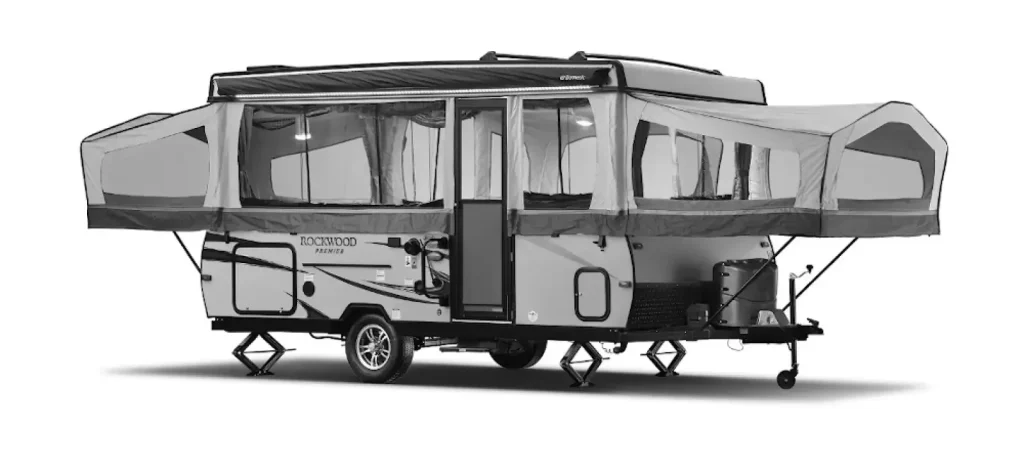
- Sleeps: 4–6 comfortably / 8 max
- UVW: 2,955 lbs
- GVWR: 3,292 lbs
- Length (closed/open): 19’1″ / 23’9″
For the perfect balance between space, comfort, and versatility, nobody does it better than the Rockwood Premier 2516G from Forest River. With a slide-out dinette, a king-size bed, and a small on-board bathroom (separated by a privacy curtain), the Rockwood Premier packs a serious punch, all with a dry weight of less than 3,000 lbs.
That slide-out dinette does stand out as a top feature. It opens up the Rockwood’s interior and creates an almost airy feeling that’s rare amongst pop-up campers. While I wouldn’t say it’s the best pop-up for families overall, it is still definitely built to accommodate a couple of kids.
Meanwhile, Forest River cranks the comfort up to eleven with the Rockwood’s interior. There’s ample under-seat storage, a power lift system for breezy setup, and even a heated mattress (yes, seriously). This camper is equally ready for quick getaways and extended road trips alike!
It is still a heavy model compared to other units on the market. With a UVW close to 3,000 lbs, you’ll need a mid-size SUV or pickup truck to tow it safely. For example, you might barely scrape by with some Jeep Wrangler models’ towing capacities, but that’s the absolute lowest you can go. (And even then, it’s dicey.)
But realistically, with all the extras it offers, that weight is just the cost of comfort. With this offering from Forest River, you get a premier pop-up with some serious brand recognition. That’s why it’s our pick for the best!
Best Budget
2. Best Budget: Coachmen Clipper LS 806XLS
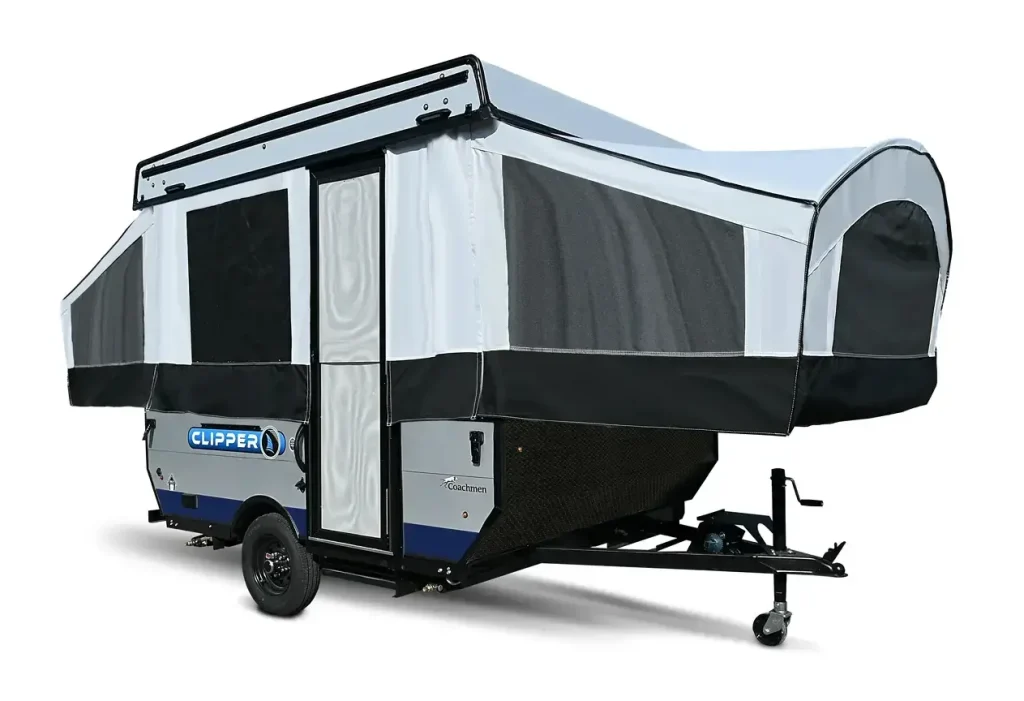
- Sleeps: 3–4 comfortably / 6 max
- UVW: 1,642 lbs
- GVWR: 2,897 lbs
- Length (closed/open): 12’11” / 17’11”
Chasing big adventures on a small budget? Then the Coachmen Clipper is one of the smartest plays in the pop-up game. It’s light, it’s easy to tow, and best of all, it’s mega affordable.
First up, it is most definitely a lightweight rig. Tipping the scales at just 1,642 lbs (UVW), you won’t need a beefy pickup to tow this camper. Many mid-size SUVs can handle it no problem. So for newbie RVers and weekenders who don’t want to upgrade their everyday vehicle, the Clipper is perfect!
But despite its small footprint, this camper is still rated for up to six sleepers max. That’s thanks to its two 48″ tent-end beds plus dual 60″ gaucho sofas that double as sleeping options. I wouldn’t necessarily say there’s enough room for a whole family to comfortably live inside. But if you pick up a couple of hitchhikers, there’s always the option to house them!
Regarding the amenities and utilities, the Clipper runs light. With no bathroom and a minimalist kitchen (i.e., a two-burner stove, a small sink, and fridge), it doesn’t offer the same oomph as the Rockwood or our next option. It’s also limited on storage, meaning you might need some smart space-saving ideas to make all your gear fit.
But at a sub-$20K price point, you’re certainly getting the essentials and then some! For new RVers or casual campers shopping on a budget, the Clipper 806XLS hits A LOT of marks without draining life savings. It’s simple, affordable, and ready to roll.
Best Luxury
3. Aliner Expedition
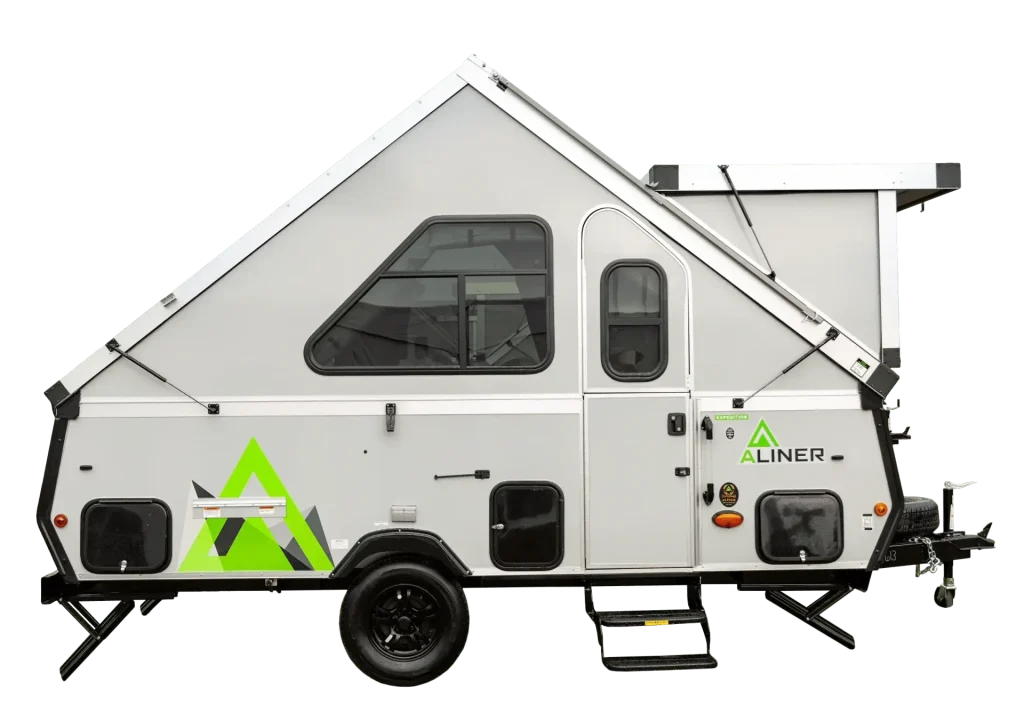
- Sleeps: 2–3 comfortably / 4 max
- UVW: 1,985 lbs
- GVWR: 3,500 lbs
- Length (closed/open): 18′ / 18′
Luxury isn’t always about size—it’s about smart design, comfort, and features that feel like home. So the Aliner Expedition, with rigid walls, a quick setup time, and a tall, A-frame design, serves as a real upgrade over traditional tent campers without the bulk of a full trailer.
Right off the bat, this rigid A-frame design sets this camper apart. Unlike soft-sided models, the Expedition’s hard walls offer more insulation, weather resistance, and noise reduction for a better night’s sleep, especially in all those crowded budget RV parks. Plus, A-frame designs tend to be much easier and quicker to set up with minimal fuss required!
So the extra headroom allows you to stand tall… But wait, there’s more! Inside, Aliner has implemented an array of smart ideas to make use of every inch of room. A rear sofa bed and a front dinette convert into a secondary bed, with the high-peaked ceiling ensuring things still feel open.
However, what really earns the Expedition its luxury label is the amenities. We’re talking a…
- Swivel cassette toilet
- Microwave
- Fridge with freezer
- And even hypoallergenic foam cushions
All straight outta the box!
There are a couple of quirks to the Expedition. The A-frame peaks your headroom in the middle but offers less room on the sides than larger, boxier pop-ups. And storage space is limited.
But the upside is premium living on a pop-up schedule. I wouldn’t actually say this luxury option is best for families and kids. But singles and couples with disposable income and a love of lavish rides will love the upscale, nimble design.
Best Off-Grid
4. Opus OP4
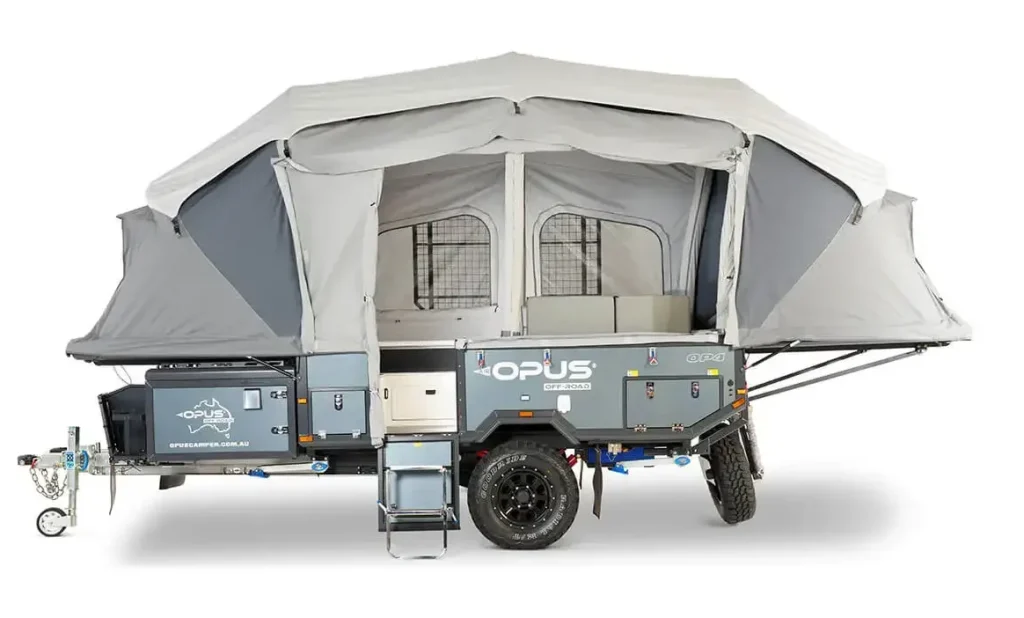
- Sleeps: 4–5 comfortably / 6 max
- UVW: 3,100 lbs
- GVWR: 4,200 lbs
- Length (closed/open): 17′ / 20′
Dusty tracks, rocky climbs, remote hideouts far from hookups and noisy neighbors… Ahhh, the off-grid boondocking lifestyle. For going to the nowhere places (i.e., the best places!), the Opus OP4 is your off-grid soulmate. Boasting an independent coil suspension system and dual shock absorbers alongside a full onboard battery and water system, this beast is built for backcountry exploration.
Firstly, let’s talk off-road rides. The OP4 is basically a mountain goat in trailer form. The independent suspension is complemented by an articulating hitch and massive clearance. I can say from personal experience, you can get away with A LOT on sketchy roads with clearance like that alone.
The design is clever too, for anybody who treats RVing like an on-the-road project. It’s got a slide-out kitchen, huge front toolbox, and dedicated space for batteries, water tanks, and solar gear. It’s a storage-friendly, gear-hauling, overland-ready rig.
But the coolest party trick? The inflatable Airbeam setup. No poles, no clips, no fart-assing around in the rain. All you do is hit a button, and the camper inflates itself in under 5 minutes using its onboard air compressor. Easy peasy, lemon-squeezy.
Now, it is a heavy boy (but with the GVWR to match). For an off-road camper like this, you’ll need a tow vehicle to match. Something like a bulky pickup or 4×4 is much better suited for the off-grid adventures.
But man, the off-grid adventures are fun! There’s really no contest here. If you want both a pop-up camper AND to live the off-grid RV lifestyle, the Opus OP4 is the best trailer for the job.
Best For Families
5. Forest River Rockwood Roo 17E (Hybrid)
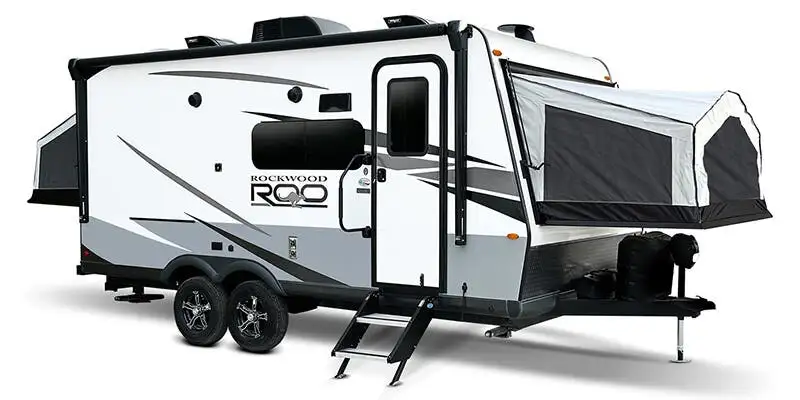
- Sleeps: 2–4 comfortably / 5 max
- UVW: 3,858 lbs
- GVWR: 5,464 lbs
- Length (closed/open): 18’9″
For families who want the flexibility of a pop-up without giving up the comfort and privacy of a full motorhome monster, the Rockwood Roo 17E nails the sweet spot. Technically, it’s a hybrid compared to other models on this list. But it’s the structural and interior design that conclusively secures its position as the ultimate fam-bam-mobile for camping trips.
Let’s start with the layout—you get two queen beds, one in the rear and one up front. Families of four will have plenty of sleeping space for everyone! But if you do have a fifth rugrat, the converted dinette is the backup option.
The 17E also delivers a big-ticket upgrade most pop-ups skip: a fully enclosed dry bath with hard walls. That means the shower is covered and enclosed, separate from the toilet. Plus, the whole bathroom is properly cordoned off without the leaky aromas. (Which is MORE than ideal for a traveling family.)
Additionally, the Rockwood is built as a hard-sided hybrid. Similar to the Aliner, the rigid walls complement the solid floor for better insulation, noise control, and all-around safety. It’s perfect for sudden wild weather!
The tradeoff is that this is the heaviest camper trailer on the list. Even on-road, you’re going to need a chunky monkey for the tow, much like the OP4.
That said, many families enjoying the RV life will likely already have a suitable vehicle. And if you want a hybrid that ensures all members are getting a solid night’s sleep, you can’t do much better than this other option from Forest River. They’re one of the most popular RV brands in this space for a reason!
Last Tips on Choosing the Best Pop-Up Trailer for Your Camping Style
So, by now, I hope you have a strong finger on the pulse of what is right for you.
You’ve seen the top models in all their glory. But before you proceed to dropping that cash, I have a few final tips for you.
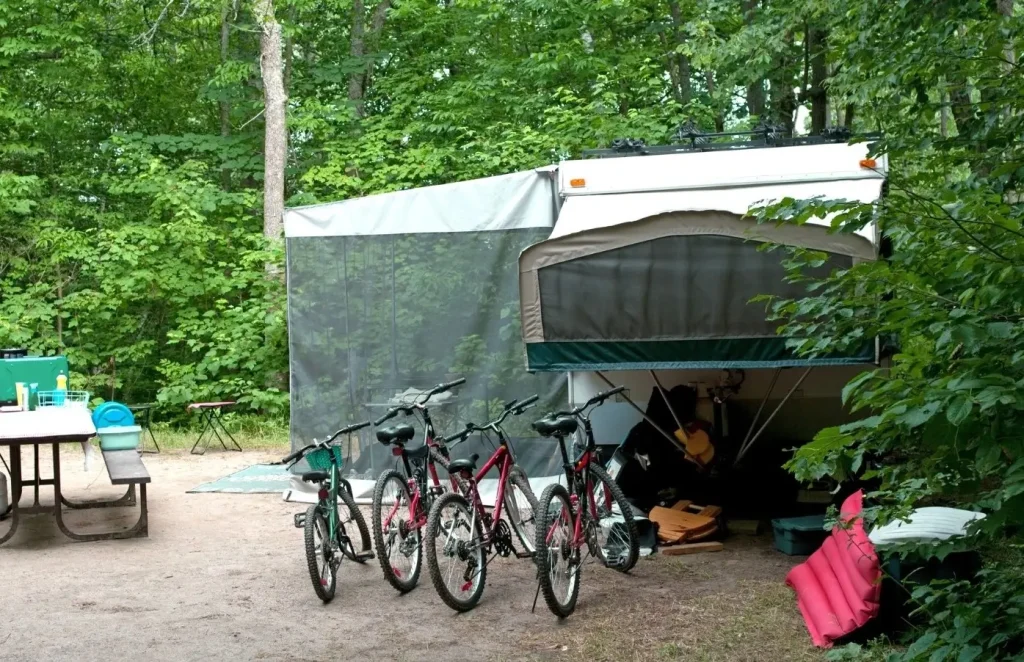
These are the little things even seasoned RVers wish they’d known before buying:
- Consider where you camp most often. Dry camping off-grid? Campgrounds with full hookups? Be sure your camper’s water, power, and insulation systems are built to match.
- Consider the setup process. Setup fatigue is real. If you generally move camp every day or two, a quicker setup time (e.g., with an electric lift system) will make a huge difference.
- Consider your driveway or garage clearance. Many pop-ups, while versatile, are still a nightmare to maneuver into storage at home. Pre-plan!
- Consider your real tow limits. It’s not just about vehicle rating. Add in gear, passengers, and the tongue weight (aka ‘hitch weight’) too.
- Consider the weather you’ll camp face. Rain or snow, packing up wet canvas sucks. If you face those climates a lot in your travels, a hard-wall or hybrid design might be a better call.
- Consider the model’s longevity. It’s worth investing in quality from the start! Pop-up campers overall face more wear and tear than motorhomes or traditional trailers, so go for top-shelf quality assurance.
FAQs About Pop-Up Campers
Got a few lingering questions? Of course you do!
Pop-up campers are a unique breed. Having all the facts will ensure you find the right one for you.
What is the life expectancy of a pop-up camper?
With proper care and maintenance, a pop-up camper can last 15 to 20 years, and sometimes even longer. It all comes down to how you use it, where it’s stored, and how well you maintain the canvas, seals, and roof. Water damage is the silent killer of pop-ups: keep your RV dry, run regular maintenance, and be sure you fully winterize it for seasonal storage.
Do any pop-up campers have a toilet?
Yes, many pop-up campers do come with built-in toilets, especially higher-end or hybrid models. On this list alone, the Rockwood Premier, Aliner Expedition, and Rockwood Roo 17E all have toilets out of the box. Others, like the Opus OP4, come ready for a portable toilet installation. Overall, though, bathroom amenities are very changeable from model to model with a lot of different formats, so ensure you research this factor specifically if it’s a priority.
Do pop-up campers stay warm?
They can… but it depends on the model of pop-up and its setup. Soft-sided pop-ups have minimal insulation, so in colder weather, you’ll want to use a good space heater in your RV (and maybe thermal curtains or a heated mattress). Hard-sided pop-ups and A-frames like the Aliner Expedition hold heat much better. You’ll also want to seal any drafts and use reflectix or insulated window panels to trap warmth.
Is it worth buying a pop-up camper?
Yes, absolutely! If you want a more comfortable camping experience without the cost or commitment of a full-size RV, then it’s a hard yes—pop-up campers are absolutely worth it. They offer a solid middle ground between tent camping and travel trailers. More than that, they’re easier to tow, easier to store, and far more affordable, perfect for minimalists, beginner RVers, or casual campers.
Final Verdict: What’s the Best Pop-Up Camper for the Roads Ahead?
Pull up and pop up! That’s the wrap, so I hope by now, you’ve found yourself, your family, or your traveling furry fwend the best pop-up camper for the adventures ahead.
The editor’s pick (i.e., me!) was, of course, the Forest River Rockwood Premier 2516G. With a premium-design-meets-premium-features approach, it’s the best all-round heavy hitter.
That said, I personally am partial to the boondocking lifestyle. If you also sit in that niche, I’m going to point you toward the Opus OP4 once more. You just can’t look past those robust built-in systems or that sexy suspension and clearance.
Whether you’re replacing your existing RV or just completing your fleet, pop-ups are a seriously good investment. And if you haven’t tried the tow-life, they might just be the best place to start thanks to their affordability and versatility!
So again, pull up and pop up. It’s time to load your RV up with all the essentials and roll out. Motor-homies might rule the roads, but tow-folk are the ones who truly explore them.
And with the best camper trailing behind you, well… Your adventure is sure to pop off. 😉
